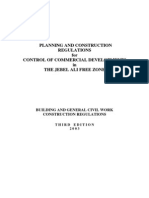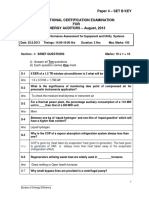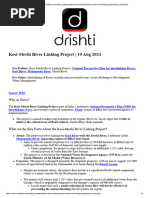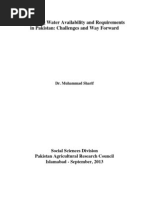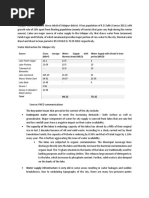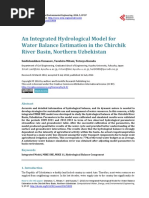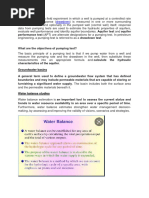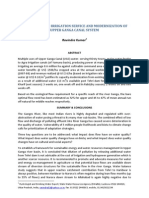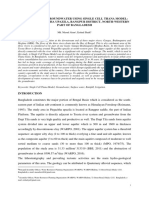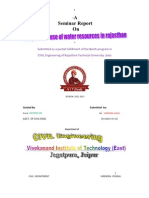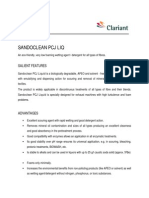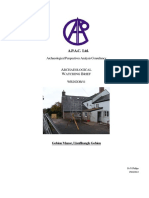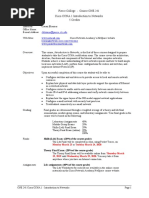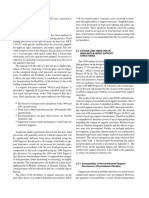765 65445
765 65445
Uploaded by
Joshi DhvanitCopyright:
Available Formats
765 65445
765 65445
Uploaded by
Joshi DhvanitOriginal Description:
Original Title
Copyright
Available Formats
Share this document
Did you find this document useful?
Is this content inappropriate?
Copyright:
Available Formats
765 65445
765 65445
Uploaded by
Joshi DhvanitCopyright:
Available Formats
Working Paper No.
147
AUGMENTING OR DIVIDING?
SURFACE WATER MANAGEMENT IN THE WATER SCARCE RIVER
BASIN OF SABARMATI
M. Dinesh Kumar, Vishwa Ballabh and Jayesh Talati
Institute of Rural Management Anand
Post Box. No. 60, Anand, Gujarat (India)
Phones: (02692) 60 181, 60 186, 60246, 60 391, 61 502
Fax: 02692- 60 188. Email: corpas@fac.irm.ernet.in
Website:http://irma.irm.ernet.in
May 2000
List of Abbreviations
AID Ahmedabad Irrigation Division
AIPC Ahmedabad Irrigation Project Circle
AMC Ahmedabad Municipal Corporation
CAD Command Area Development
CPCB Central Pollution Control Board
Cusecs Cubic Feet per Second
GOG Government of Gujarat
GPIC Gandhinagar Panchayat Irrigation Circle
HID Himmatnagar Irrigation Division
HIPC Himmatnagar Irrigation Project Circle
ICA Irrigable Command Area
MCM Million Cubic Metre
MI Minor Irrigation
NWRWSD Narmada Water Resources and Water Supply
Department
PIPC Palanpur Irrigation Project Circle
AUGMENTING OR DIVIDING?
SURFACE WATER MANAGEMENT IN THE WATER SCARCE RIVER BASIN OF
SABARMATI
M. Dinesh Kumar, Vishwa Ballabh and J ayesh Talati
1
Abstract
The paper is based on a study of irrigation system governance in Sabarmati River Basin in
Gujarat, Western India. The paper argues that the basins surface water resources had been
grossly over-estimated due to lack of adequate scientific data on the dependable yields. Also,
the basins storage and diversion schemes have been built to capture the variable runoff,
having very low probability of occurrence. This has not only inflated the irrigation benefits
from the schemes planned, but also led to increase in cost per unit volume of water captured
and over-appropriation of the basins runoff, with major ecological and environmental
consequences. The lack of basin approach to water development planning results in
reallocation of the available water rather than adding to the aggregate supplies, leading to
conflicts between the traditional users.
The irrigation governance in Sabarmati basin is based on ad hoc and age-old norms, rather
than hydrologic system considerations, making efficient planning and management an
impossible task. Further, the co-ordination structure established to plan, build, operate and
manage the irrigation schemes in the basin is not in congruence with the type of human
relations and interactions demanded by the configuration of the existing physical systems,
leading to sub-optimal utilisation of irrigation water. For efficient and optimum water
allocation planning and water management, the authors suggest, the various levels in the
organisational hierarchy need to be re-constituted on the basis of hydrologic units rivers to
rivers systems to sub-basins to basin. Further, the new governance structure should
encourage co-ordination between operational units within and across levels in the
organisational hierarchy, as demanded by the interaction existing between the physical/
hydraulic systems being managed by them.
1
AUGMENTING OR DIVIDING?
SURFACE WATER MANAGEMENT IN THE WATER SCARCE RIVER BASIN OF
SABARMATI
1.0 INTRODUCTION
The Sabarmati River basin, one of the inter-state river basins in Gujarat, has a total area of
21,085 sq. km. It is also one of the 18 major river basins in India. The total annual surface
runoff in the basin is estimated to be 3.7 billion cubic metres (Chaturvedi 1976). The basin
supports a population of 9.28 million people, 48.5 percent of which is in urban areas, and is
the citadel of many economic activities. Its water resources are appropriated for irrigation,
providing drinking water supplies for rural and urban areas and for industrial uses, while the
in-stream uses of river flows as washing, bathing, sanitation, and effluent disposal are quite
significant. Therefore, it plays an important role in the socio-economic development of the
region. It is one of the water scarce basins in India and is characterised by a number of
competing uses--rural domestic and irrigation, urban domestic and industrial (Ballabh and
Singh 1997; Kumar et al. 1999).
Surface water forms an important component of the basins fresh water, the most important
source of which is the Sabarmati River system consisting of a trunk river, six main tributaries
and several small sub-tributaries (GOG 1994). Demographic and other socio-economic
trends such as growing population, mainly urban population, rapid industrialisation and
expansion in irrigated agriculture are causing ever-increasing demand for fresh water, putting
increasing pressure on the limited surface water resources in the basin along with
groundwater (Ballabh and Singh 1997; Kumar et al. 1999). To cope with these demands, the
basins runoff had been harnessed to the fullest extent through 2 major, 11 medium and many
hundreds of small water harvesting structures, leading to over-appropriation of surface water.
Increasing pollution of surface water bodies cause sharp reduction in the availability of
freshwater in the basin. Excessive development of groundwater has led to falling
groundwater levels, seasonal drops in water levels, and deterioration of groundwater quality,
resulting in scarcity of groundwater in many areas in the basin. As demand continues to grow
from competing use sectors, water scarcity is emerging as a major water management
challenge in the basin (Kumar et al. 1999).
Water resource development projects are presumably planned and implemented on the basis
of scientific analysis of historical data of rainfall and runoff to arrive at the dependable
yields. Often, planning is carried out in the absence of adequate data on the historical runoff
and dependable yields. In some cases, the yield estimates are carried out for particular
catchments within a basin, not considering the factors that affect the overall water availability
within the water system.
2
The present paper is an attempt to study the consequences of such an approach on the overall
water governance. The paper analyses the complex water systems of Sabarmati Basin and the
historical runoff data for the sub-basins falling within. The paper also studies the governance
system created for managing irrigation and water supplies in the basin, and analyses the
irrigation and water supply performance of the systems.
The paper argues that unscientific planning of reservoirs and diversion schemes led to
inflated irrigation and economic benefits, enhancements in cost per unit volume of water. It
also shows that piecemeal approach to water development leads to over-appropriation of the
basins runoff and reallocation of available water in the basin, resulting in social and
ecological crisis. The paper also shows that governance of irrigation systems is based on
norms rather than hydrologic and hydraulic system considerations, making efficient planning
an impossible task. Further, the co-ordination structure established to plan, build, operate and
manage the irrigation schemes is not in congruence with the type of human relations and
interactions demanded by the configuration of the physical systems.
2.0 WATER SYSTEMS IN SABARMATI RIVER BASIN
2
A map of Sabarmati River Basin, with sub-basins, is shown in Figure 1. The 419 km-long
trunk-river Sabarmati, originating from the Aravalli hills of Rajasthan near the popular shrine
of Amba Bhavani, with its 6 main tributaries namely Sei, Wakal, Harnav, Hathmati, Watrak
and Bhogavo, several sub-tributaries and small rivers, constitute the surface water system of
Sabarmati Basin. The first two tributaries namely Sei and Wakal join the main river before it
enters Gujarat and is within the Rajasthan part of the Basin. The confluence point of Harnav
River with the Sabarmati is located just upstream of the Dharoi Dam situated in village
Dharoi of Kheralu taluka in Mehsana district of Gujarat State. Dhamni, one of the two east
flowing rivers in Sabarmati Basin, merges with the river upstream of Dharoi dam. Hathmati
tributary that joins the main river downstream of Dharoi dam has three sub-tributaries
namely Hathmati, Indrasi and Guhai. This river system of Hathmati, Guhai, Indrasi and
Khari constitute the Hathmati sub-basin. The Watrak tributary joins the main river a few
kilometres downstream of Wasna barrage situated downstream of Ahmedabad City. It
emerges out of the confluence of Shedhi, Watrak, Meshvo and Mazam. These four rivers
constitute the Watrak river system and the sub-basin, which make the largest contribution to
surface water flow in the basin. The River Bhogavo joins the trunk a few kilometres
upstream of the river mouth.
The basin has three sub-basins namely Dharoi, Hathmati and Watrak. The estimated runoff
for the Dharoi sub-basin based on the historical rainfall data (1951-1991) and the rainfall-
runoff relation established for the sub-basin are available from the Government of Gujarat.
The actual runoff measured for the sub-basin upstream of Dharoi dam is also available. As
per the records, the maximum runoff of 3677.38 MCM was observed during the year 1973,
against an estimated runoff of 3946.86 MCM and a minimum of 58.8 MCM during 1987,
against an estimated runoff of 15.88 MCM. This corresponds to the year with the maximum
rainfall of 127.84 cm (1973) and a minimum rainfall of 14.77 cm in 1987 (GOG 1994).
Figure 2 shows the graphic representation of the estimated and actual runoff with respect to
time for Dharoi sub-basin.
3
4
In the case of Hathmati sub-basin, the estimated runoff based on the historical rainfall data
(for the period from 1951 to 1991) and the rainfall-runoff relation established for the sub-
basin are available. The maximum estimated annual runoff is 1812. 24 MCM for the year
1976 corresponding to the rainfall of 122.31 cm and minimum estimated annual runoff is
51.202 MCM for the year corresponding to the rainfall of 20.96 cm observed during the year
1987 (GOG 1994). Figure 3 shows the graphic representation of the estimated yield with
respect to time for Dharoi sub-basin.
Several large, medium and small storage and diversion structures that cut across the big and
small rivers and drainage lines make significant alterations in the natural flows in Sabarmati
Basin. They are unique by virtue of the hydraulic interactions they establish between various
rivers, and in a few instances between sub-basins. They make the water system of Sabarmati
basin one of the most fascinating water systems for researchers dealing with governance of
water systems as well as for hydrologists.
2.1 Water Systems on Sabarmati River
The Dharoi Reservoir scheme, the largest storage scheme in Sabarmati basin, is located in
village Dharoi in Kheralu taluka of Mehsana district. The dam had an initial dead storage of
89.941 MCM and a live storage of 775.89 MCM. Water was first released for drinking in
Ahmedabad and Gandhinagar in 1976 and irrigation in 1980. The reservoir was planned to
provide irrigation to a total command of 45,548 ha in Mehsana district and 11,130 ha in
Figure 3 Total Estimated Dependable Yield of Hatmati Sub
Basin in MCM
0
500
1000
1500
2000
1950 1955 1960 1965 1970 1975 1980 1985 1990
F i g u r e 2 E s t i m a t e d a n d O b s e r v e d R u n o f f o f
D h a r o i S u b B a s i n i n M C M
0
500
1000
1500
2000
2500
3000
3500
4000
4500
1950 1955 1960 1965 1970 1975 1980 1985 1990
T otal a nnual runo ff T otal obs erv ed runoff
5
Sabarkantha district, and provide water to Ahmedabad and Gandhinagar at a rate of 150 mgd
and 11 mgd respectively for municipal water supplies and power generation.
The Fatehwadi irrigation project involved the construction of a barrage at Wasna and a feeder
canal for feeding water to the already existing canal system. The Wasna barrage was meant
to divert the runoff available in the free catchment of the basin starting from Dharoi dam and
the excess runoff released from the dam. Another source of water for the Fatehwadi canal
system is the urban sewage from Ahmedabad City, estimated to be around 330 thousand
cubic metres daily. During the kharif season, a mix of river runoff and the effluents make up
for the supplementary irrigation requirements, while in the winter season, the effluent alone
is used to meet the crop water requirements.
2.2 Harnav Water System
The river system of Harnav has one medium dam (known as Harnav Phase II) and three
weirs. Two of the weirs were constructed during the pre-independence period by the former
princely state and are located downstream of Harnav dam. The third weir, Chhapra weir, was
built in 1958. The Harnav dam was built upstream of Chhapra weir in the year 1988. The
water released from the Harnav dam is used to meet the water requirement of the 3 weirs.
The spill over from the weirs enters the Dharoi reservoir as inflow.
2.3 Hathmati Reservoir System
The Hathmati reservoir project on the Hathmati river system has three medium dams,
namely, Hathmati, Indrasi and Guhai and a pick-up weir. The Hathmati reservoir has a live
storage of 149.02 MCM and dead storage of 3.51 MCM. The Indrasi dam, located on the
Indrasi River has live storage and dead storage of 0.39 MCM and 18.8 MCM respectively.
The Hathmati canal system is one of the oldest irrigation systems in Gujarat. It has four
zones A, B, C and D. The zone A of the command area receives water from the main canal
off-taking from the Hathmati dam.
An escape has been provided in the Hathmati main canal to release water from the reservoir
in to the Hathmati River. The Himmatnagar (Hathmati) pick-up weir would pick up this
water for releasing to zone B, C and D. The Zone B receives water through the main canal
off-taking from the Hathmati weir. During floods, water is released in zone B canal, which is
diverted and stored in Limli reservoir-- through Bokh feeder canal off-taking from zone B
canal and Karol reservoirthrough Hathmati main canal and Karol feeder. The stored
water in the dams is released in Khari River. Water is also released from the Hathmati zone B
canal into the Khari River through an escape canal, Bhujwa. The Raipur weir picks up the
water for irrigation in zone D under the Kharicut canal system.
Guhai dam, the most recently built dam in the Hathmati system, is located upstream of the
Himmatnagar pick-up weir on the Guhai River.
6
2.4 Kharicut Canal System
The Kharicut canal system, started in 1880 with the construction of a weir on the Khari River
in Raipur village of Ahmedabad, is one of the oldest irrigation schemes in Gujarat. In the
earlier days, flows in the Khari River were sufficient to divert for irrigation of the large tracts
of paddy fields. But, after the construction of Limli and Karol dams in the upstream, water
had to be released from the Hathmati and Indrasi reservoirs to maintain kharif irrigation in
Kharicut command.
2.5 Irrigation Projects in Watrak River System
The reservoir projects in the Watrak river system are Waidy, Meshvo, Mazam, Waidy and
Watrak. The only river diversion project is the Meshvo Canal System. The Watrak reservoir
scheme, located on Watrak River, is the oldest of all. The dead storage and live storage
capacities of the reservoir are 8.49 MCM and 134.25 MCM respectively. The project
envisaged bringing an area of 16,874 ha in Bayad and Malpur talukas of Sabarkantha district
and Kapadvanj taluka of Kheda district under irrigation.
The Meshvo canal system, older than Meshvo reservoir project, is a river diversion scheme
consisting of a pick-up weir located at a village named Raska in Memdabad taluka of Kheda
district and a canal system. The canal system helps in irrigating the areas under the direct
command of 10,320 ha and feeding water to the several existing storage tanks located in the
command areas during floods. The tanks have a total capacity of 15.64 MCM and could
irrigate a total area of 2928 ha. The storage is helpful in reducing the service area under
direct command during lean flow periods.
Meshvo reservoir scheme is located on Meshvo River, a tributary of the Watrak River. The
dead storage and live storage of the dam are 4.87 MCM and 77.20 MCM respectively.
Situated on the upstream of the Raska pick-up weir, the Meshvo reservoir has a command
area of 7972 ha. The Mazam irrigation scheme is located on Mazam River, a tributary of
Watrak River. The dam had a dead storage of 3.37 MCM and a live storage of 34.76 MCM
respectively. The reservoir project has a cultivable command area of 4717 ha. The Waidy
reservoir scheme is situated on Waidy River, a tributary of Watrak River, near village
Bhempur in Meghraj taluka of Sabarkantha district. The dead storage and live storage of the
reservoir are 1.33 MCM and 12.27 MCM respectively.
3.0 GOVERNANCE OF WATER SUPPLY SYSTEMS IN SABARMATI BASIN
3.1 Narmada Water Resources and Water Supply Department
The Narmada Water Resources and Water Supply Department (NWRWSD) is concerned
with survey, planning, investigation and development of water resources in the State of
Gujarat. The departments mandate is to create irrigation facilities for the development of
agriculture in the State, provide drainage facilities in the command areas, irrigation
7
governance and creating drinking water supply facilities for thousands of villages and several
hundreds of towns based around water from Sardar Sarovar project.
The department has 4 corporations: 1) Sardar Sarovar Project, Narmada Corporation, headed
by Secretary; 2) Gujarat Water Resources Development Corporation; 3) Command Area
Development Commission for Ukai-Kakrapar, headed by a Commissioner; and, 4) Command
Area Development for Kadana, headed by a Commissioner.
The NWRWSD has 33 circles of which two are Water Resources Investigation Circles
(WRICs) dealing with survey and investigation of water resources in the state. They are the
Ahmedabad Water Resources Investigation Circle and the Rajkot Water Resources
Investigation Circle. The Ahmedabad Water Resources Investigation Circle carries out
survey, investigation and preparation of preliminary report for large, medium and minor level
irrigation projects of 12 districts, namely, Ahmedabad, Baroda, Valsad, Dang, Surat,
Bharuch, Kheda, Panchmahal, Sabarkantha, Banaskantha, Gandhinagar and Mehsana. It is
headed by a Superintending Engineer and has 8 divisions and 33 sub-divisions. The
NWRWSD is the largest State government agency in Gujarat with technical staff strength of
more than 12,000 persons.
3.2 The Organisational Structure and Governance System
Focusing on irrigation management requires one to view irrigation management not only as a
socio-technical enterprise, but also as organisational or managerial one. It is important to
know what are the human relationships associated with management of irrigation systems.
The socio-technical system sets new constraints as well as opportunities in water
management (Uphoff et al. 1991). Since there is an explicit relationship between
organisational structure and functions, it is important to analyse the organisational structure,
its composition and functioning before one looks at the performance of the irrigation
bureaucracy. Whereas structure does not guarantee performance, inappropriate structure is a
virtual guarantee for sub-standard performance (Hunter District Water Board 1982:24)
The organisation has a pyramid-like structure created by a multi-layer hierarchy of officials
with powers and responsibilities reducing from top to bottom. The head office is at the State
capital, Gandhinagar. The senior technical officers, including the Secretary and the Chief
Engineers, operate from the head office. Under the head office, there are circle offices, which
are headed by and under the direct supervision of a Superintending Engineer. Normally, there
is one circle office functioning under a Chief Engineer, while in a few cases there are two.
Normally, there are 3-4 divisions under each circle office and each division is headed by an
Executive Engineer. Each division has normally 60,000-100,000 ha of command under its
jurisdiction. Functionally, there are two types of divisional offices. The first one looks after
the construction of head works and canals and is known as Project Headwork Division. The
second type looks after irrigation management and is known as Irrigation Project Division.
The total command area of the irrigation schemes, including those which are being executed
and managed by the circle office, would determine the number of divisions functioning under
it.
8
Under each division, there are 5-6 sub-divisions. Depending on the stage of implementation
of schemes, different sub-divisional offices can be looking after different types of functions
such as headwork, network, quality control, canal systems and irrigation management. As per
the norms of the department, there should be one sub-divisional office to deal with irrigation
management aspects alone, for a total design command of 15,000-20,000 ha. Due to this
reason, many a time, there is more than one sub-divisional office dealing with one irrigation
system, depending upon the total Irrigable Command Area (ICA) under the system. Again, as
per the norms, each division should be handling around 1lakh hectares of irrigation
command.
The sub-divisional offices are directly concerned with execution of irrigation projects,
irrigation system governance and water management and therefore are the backbone of the
department. A Deputy Executive Engineer heads the sub-divisional office. The Deputy
Executive Engineer with the technical support of other staff including Section Officers (in
the rank of Assistant Engineer), and Beat Karkuns (Work Assistants) perform the day to day
affairs of the sub-division. Next in the hierarchy after a Deputy Executive Engineer is a
Section Officer, who is in charge of a command of 4000-5000 ha. There are Beat Karkuns
under each Section Officer and Chaukidars (Beat Guards) work under them. According to
the department norms, there shall be 84 staff in each sub-division, which looks after the
irrigation management functions for a total designated command area of 15,000 ha.
There are a total of 8 levels in the organisational hierarchy starting from Secretary to Chief
Engineer, Superintending Engineer, Executive Engineer, Deputy Executive Engineer, Section
Officer, Beat Karkun to Chaukidar. The job responsibilities of both office functionaries
(Secretary to Deputy Executive Engineer) and field functionaries (starting from Section
Officer to Chaukidar) are clearly defined. The minimum qualification for all positions from
Secretary to Deputy Executive Engineer is a graduation in Civil Engineering. A Section
Officer is either a degree or diploma holder in Civil Engineering. A degree holder in any
discipline is eligible for the post of Beat Karkun (source: Gulati, undated).
The irrigation management in Gujarat is governed by the Bombay Irrigation Act, 1879 and
Gujarat Canal Rule, 1962 as amended from time to time. The distribution system is Shejpali,
which is basically a demand based supply system in which each irrigator has to apply to the
irrigation agency before the beginning of each season. The Section Officer receives the
applications from the farmers through the Beat Karkun. Sanction of application for irrigation
is conveyed to the farmer by the Section Officer through the Beat Karkun in the form of an
irrigation pass. Every time the farmer avails off irrigation, he/she has to obtain the signature
of the Chaukidar in the irrigation pass and similarly he has to sign in the duplicate copy of
the irrigation pass kept with the beat guard (source: Gulati, undated).
The financial powers vested with different levels are as follows. The Secretary and Chief
Engineers have powers to sanction funds for scheme costing more than 15 lac rupees. The
Superintending Engineer sanctions funds for schemes costing above 5 lacs and up to 15 lacs.
The Executive Engineer can sanction works costing 0.50-5.0 lac rupees. The Deputy
Executive Engineer has power to sanction works costing up to 50,000 rupees. Thus, the
lowest office in the organisational hierarchy has the least financial powers, while the key
9
financial powers are vested with the senior most officials such as Secretary and Chief
Engineers. The Deputy Executive Engineers are, nevertheless, vested with powers to carry
out repairs and maintenance depending on the availability of grants.
The Administrative powers related transfer of technical staff is only vested with Secretary,
while the powers for recruitment of all technical and non-technical staff, including the ad hoc
and temporary staff are vested with the government. It is important to note here that the
transfer of all technical and non-technical staff in the department is subject to political
interference.
4.0 IRRIGATION GOVERNANCE IN SABARMATI BASIN
Irrigation governance broadly refers to planning, building, operation and maintenance of
irrigation infrastructure starting from storage and diversion head works to distribution
systems up to the outlet level; water allocation planning; water distribution; preparation of
schedules for water release to individual farmers; water delivery services; recovery of water
charges; and resolving conflicts and disputes related to water releases (Uphoff et al. 1991).
The total number of major and medium irrigation schemes in the basin is 13 and the design
command area of all these systems put together comes to 1,72,538 ha. The Circle-wise break
up of technical and non-technical staff in the department is given in the Table below.
Table 1: Circle-wise Staffing Pattern for Sabarmati River Basin
Name of Circle Technical Staff
(Approved/
Filled)
Non-technical Staff
(Approved/Filled)
Total Staff
(Approved/Filled)
PIPC
GPIC
HIPC
AIPC
351/N.A
331/223
181/175
216/314
272/N.A
363/261
227/222
239/225
623/N.A
694/484
408/397
455/539
The total staff strength of the department covering all the circles, divisions and sub-divisions
looking after the irrigation schemes in the Basin is estimated to be around 2000.
4.1 Governance Structure
The governance structure for the irrigation systems falling under the Sabarmati basin is as
follows. There are 3 chief engineers, who are responsible for the irrigation and water supply
schemes in Sabarmati River Basin, Chief Engineer -Command Area Development, Chief
Engineer-Irrigation Projects and Chief Engineer-Minor Irrigation. There are 4 irrigation
project circles under the jurisdiction of these 3 Chief Engineers and directly concerned with
the schemes in Sabarmati Basin. They are Ahmedabad Irrigation Project Circle (AIPC),
Himmatnagar Irrigation Project Circle (HIPC), Palanpur Irrigation Project Circle (PIPC) and
Gandhinagar Panchayat Irrigation Project Circle (GPIC).
10
The AIPC is under the J urisdiction of the Chief Engineer Command Area Development.
The Chief Engineer- Irrigation Projects has two Project Circles namely HIPC and PIPC
under his jurisdiction. The GPIC is under the jurisdiction of Chief Engineer-Minor Irrigation.
The governance structure below the Circle Level is discussed in the following section.
4.1.1 Ahmedabad Irrigation Project Circle (AIPC)
The AIPC has 2 divisions concerned with the Sabarmati Basin: Ahmedabad Irrigation
Division (AID) and Himmatnagar Irrigation Division (HID). The Ahmedabad Irrigation
Division has 7 subdivisions. Of these, the Ahmedabad Irrigation Subdivision looks after
Hathmati Zone- D command area, and the Sanand Irrigation Subdivision looks after nearly
40 percent of Fatehwadi Command. The Bavla Irrigation Sub-division looks after the rest of
Fatehwadi command. The Bareja Irrigation Subdivision looks after Meshvo Canal System
command.
The HID has 4 sub-divisions. Of these, the Himmatnagar Irrigation Subdivision looks after
Hathmati Zone- A and Harnav Stage I. The Prantij Irrigation Subdivision looks after
Hathmati Zone B and C of command areas. The Modasa Irrigation Subdivision looks after
Meshvo and Waidy commands. The Dharoi Irrigation Subdivision looks after Dharoi Left
Bank Canal commands.
4.1.2 Himmatnagar Irrigation Projects Circle (HIPC)
The HIPC has four completed schemes under it, namely, Watrak, Guhai, Harnav and Mazam.
In addition, there are 5 ongoing schemes, namely, Khedva, Lank, Varanasi, Pal and Rolla.
The HIPC has four divisions under its jurisdiction, these are Project Construction Division-1
& 3, both located in Himmatnagar, and Irrigation Project Division and Watrak Project Canal
Division at Modasa.
The Project Construction Division-1 at Himmatnagar has five sub-divisions. All the five are
engaged in construction on the ongoing schemes. Project Construction Division No.3,
Himmatnagar also has 5 sub-divisions. Of these five, Harnav Sub-division 2 looks after the
irrigation management of Harnav Stage II command.
The Irrigation Projects Division has 6 sub-divisions each. Of these, Mazam Subdivision-4
looks after irrigation management under Mazam project. The Watrak Subdivision11, looks
after irrigation management under Watrak Right Bank Canal. Of the 6 sub-divisions of
Watrak project Canal Division, Watrak Canal Subdivision2 looks after irrigation
management in the Watrak Left Bank Canal command areas.
4.1.3 Gandhinagar Panchayat Irrigation Circle (GPIC)
The GPIC is concerned with all minor irrigation and recharge schemes falling within the
Sabarmati Basin. It has 3 divisions known as Panchayat Irrigation Divisions, at Palanpur,
Ahmedabad and Himmatnagar. The Palanpur Panchayat Irrigation Division has only one sub-
division named Minor Irrigation Construction Sub-division, which looks after the MI
11
schemes. The Ahmedabad Panchayat Irrigation Division has three sub-divisions: Check dams
sub-division located at Ahmedabad, Panchayat Irrigation Sub-division at Dholka, and
Panchayat Irrigation Sub-division at Gandhinagar. The Himmatnagar Panchayat Irrigation
Division has 6 sub-divisions located in Himmatnagar, Idar, Modasa, Prantij, Khedabrahma
and Bhiloda. Table 2 shows the total number of MI schemes under GPIC in the districts of
Sabarkantha, Ahmedabad and Banaskantha.
Table 2: The MI schemes under Panchayat Irrigation Circle in 3 Districts
Name of
District
Existing Schemes Ongoing Schemes
Number Ultimate Irrigation
Potential (Ha)
3
Number Ultimate Irrigation
Potential (Ha)
Ahmedabad
Sabarkantha
Banaskantha
108
626
252
7057.00
18631.00
11725.00
7
117
37
120.00
1040.00
1067.00
As Table 2 indicates, the largest number of MI schemes (626) are in Sabarkantha district and
all these fall in the Sabarmati River Basin being the fact that 98 percent of the districts
geographical area falls in the basin area. Since only 27 percent of Ahmedabad district and
6.77 percent of Banaskantha district fall in the basin, we can safely assume that the number
of MI schemes from that district falling in the basin is quite insignificant. Though almost the
entire area of Gandhinagar falls in the Sabarmati Basin, there are no MI schemes in the
district.
4.1.4 Palanpur Irrigation Project Circle (PIPC)
The PIPC looks after the head-works, and irrigation management in Right Bank Canal
command of Dharoi scheme. There are 3 divisions under the PIPC: Dharoi head-works
division, Dharoi Canal Division No.2, and Dharoi Canal Division No.3. The sub-divisions of
Dharoi Canal Division No.2 and 3 look after the Right Bank Canal commands of Dharoi
scheme.
To summarise, putting all the four Circles together, there are 13 Divisions and 60 Sub-
divisions of the NWRWSD directly concerned about the irrigation, water supply and water
harvesting systems in the Sabarmati River Basin.
4.2 Water Allocation
Normally, the concerned Superintending Engineer takes all decisions related to allocation of
water from irrigation schemes. However, for schemes that have committed to supplying
drinking water to cities and towns, the allocation decisions are taken at the higher level and
the concerned Chief Engineer or the Secretary are involved due to the politically sensitive
nature of the decisions. But, often such decisions also come under severe scrutiny by the
peoples representatives, and the political leaders of the regions concerned. In the Sabarmati
basin, 3 of the irrigation schemes are also committed to provision of urban water supplies.
While the Dharoi reservoir has to reserve water for Ahmedabad City, Watrak and Mazam
schemes are committed to supplying water for Kapadvanj town and Modasa town
12
respectively. In the years of poor rainfall and droughts, water allocation decisions for all the
irrigation schemes are left to ministerial levels and are subject to strong political interference.
4.3 Command Area Development
The slow pace of utilisation of irrigation potential created with the general lack of
preparedness on the part of farmers and official agencies to ensure optimal use of available
water, led to the Irrigation Commission ((1972) to recommend the formation of Command
Area Development (CAD) Authority (Varghese 1990). The authority came into existence in
1974-75.
The CAD Authority is charged with operation and maintenance of canal system below the 1-
cusec outlet commanding 40 hectares of irrigated land; on-farm development such as
construction and maintenance of field channels, field drains and farm roads; land shaping and
consolidation; organising warabandi or rotational water supply; devising suitable cropping
patterns with adaptive trials; developing groundwater; marketing and processing facilities for
agricultural produce; soil conservation; and planning market centres. The extent to which
irrigation management objectives can be realised, therefore, depends on the success in
implementing CAD programmes, once the scheme is completed. Funding for command area
development programme is through State and Central Contributions and institutional
financing.
Currently, there is only one Chief Engineer to look after the CAD programmes in the
Sabarmati Basin. Many irrigation schemes, in spite of being completed, are still not turned
over to the CAD Authority. There are only four irrigation command areas that are under the
jurisdiction of the CAD Authority namely Dharoi Left Bank Command, Fatehwadi
Commands, Meshvo Canal System Command, and Hathmati Command. The rest of the
commands are not able to take the advantage of funds earmarked for CAD programme by the
State and the Centre. Though, at the conceptual level, the programme has very broad
objectives, it is reduced to field channel construction at the field level. Further, the overall
progress in CAD programme has been very poor. Out of the total irrigation command of
1,78,000 ha in Sabarmati basin, the programme has so far covered only 3,082 ha (source:
GOG 2000).
4.5 Irrigation Performance
One of the indicators of the performance of the irrigation systems is the actual area served by
the systems. Hence, the key variables needed are the actual irrigated area and the design
command area. The variable termed Irrigated Area Ratio
4
can be used to express the
performance of the irrigation systems (Pitana 1991) which also reflects upon the performance
of the irrigation department. The actual irrigated area in a particular year is a function of the
rainfall in the catchments and therefore, the irrigation performance is a function of time and
space, other factors remaining constant. The irrigation performance can, thus, vary from
scheme to scheme within the same year and can also vary from year to year for the same
scheme. Here, the irrigation performance of all the schemes falling within the Sabarmati
Basin is studied for a single year (1996-97). This is sufficient to capture the spatial variations
in the rainfall across the basin. Table 3 indicates that for most of the reservoir and canal
13
diversion schemes, the actual area irrigated is much less than the design command area,
which ranges from 0.14 to 0.89 percent (for one scheme).
Table 3 Design Command Area, Actual Irrigated Area and Irrigated Area Ratio
Name of project Design Command
Area (Ha)
Irrigated Command
Area (1996-97) (Ha)
Irrigated Area
Ratio
Dharoi 56678 9469 0.167
Watrak 18341 7801 0.43
Mazam 4717 3334 0.71
Guhai 7111 4030 0.57
Harnav Stage-II 3440 213 0.62
Fatehwadi Canal System 33600 30060 0.89
Hathmati dam 5666 3319 0.195
Hathmati weir 11334
Kharicut canal 10200 1455 0.14
Meshvo Dam 7972 11353 0.62
Meshvo Canal System 10320
Harnav stage-I 1923 981 0.51
Waidy 1236 635 0.51
Total 172538 72650 0.42
In order to capture the effect of the inter-annual variability in rainfalls and runoff on
irrigation water supplies, historical data on irrigation are analysed for two schemes namely
Dharoi and Hathmati.
4.5.1 Historical Performance of Hathmati Reservoir and Canal System
Table 4 provides the historical data on actual irrigated area and irrigated area ratio for the
Hathmati reservoir and diversion systems. The design command area was 17,000 ha till 1979.
In 1980, it was increased to 27,200 ha.
Table 4 Design Command Area, Gross Irrigated Area and Irrigated Area Ratio
Year Gross Irrigated Area in
Zone A, B, C and D
(Ha)
Irrigated Area Ratio
1972
1973
1974
1975
1976
1977
1978
1979
2883
6911
1888
1676
6935
8764
5063
2356
0.170
0.407
0.110
0.091
0.408
0.516
0.298
0.139
14
1980
1981
1982
1983
1984
1985
1986
1987
1988
1989
1990
1991
1992
1993
1994
1995
1996
1997
1998
10833
10302
10002
15509
15322
326
232
0
7760
1889
6745
8686
2423
6321
9161
3289
3593
6085
3210
0.398
0.379
0.368
0.570
0.563
0.012
0.009
0.000
0.285
0.069
0.248
0.319
0.143
0.372
0.539
0.193
0.211
0.358
0.189
4.5.2 Historical Performance of Dharoi Reservoir Project
Table 5 provides the data regarding the area irrigated under the Right Bank Main Canal
(RBMC) and Left Bank Main Canal (LBMC) of Dharoi reservoir project. The design
command of RBMC in Mehsana and LBMC in Sabarkantha districts were 45,548 ha and
11,130 ha respectively. Out of 21 years of operation, the full design command area could be
irrigated only in three years (1993, 1994 and 1995) in the RBMC command and two years (1989
and 1993) in the LBMC (Puri and Vermani 1997). But, it was expected at the time of planning
of the irrigation scheme that the full design command could be irrigated in 3 out of every 4
years.
15
Table 5 Area Irrigated by RBMC and LBMC of Dharoi Reservoir Scheme
Year
Area Irrigated by the
RBMC (Ha)
Area Irrigated By
the LBMC (Ha)
1976
1977
1978
1979
1980
1981
1982
1983
1984
1985
1986
1987
1988
1989
1990
1991
1992
1993
1994
1995
1996
0
0
0
294
1097
3586
2255
15360
30046
34001
12593
0
6681
27822
16781
40957
43817
51684
45254
49034
3657
0
0
0
629
581
1013
4256
9188
12131
8966
2773
0
3641
11206
5439
10261
10285
12931
9944
7267
1906
Source: Dharoi Project Works, Irrigation Department, Government of Gujarat.
One of the reasons for the low irrigation performance has been in the gradual increase in water
allocation for Ahmedabad. The historical data shows that the volumetric release of water for
Ahmedabad steadily went up from 148.145 MCM in 1971-72 to 225.56 MCM in 1996-97 (Puri
and Vermani 1997). From 1976-77 to 1996-97, water allocation for urban uses varied from year
to year from a minimum of 7 per cent to 100 per cent of the water stored in the reservoir. In the
drought years of 1986-87 and 1987-88, almost all the water stored in the reservoir was allocated
to the urban centres of Gandhinagar and Ahmedabad (Shunmugam and Ballabh 1998).
5.0 ISSUES IN IRRIGATION GOVERNANCE IN SABARMATI BASIN
5.1 Poor System Efficiencies
Water supplies for irrigation and drinking from the surface water reserves in the Sabarmati
River Basin are managed through a complex network of reservoirs, canals and natural
drainage lines such as rivers, as evident from the description of the natural and artificial
water supply systems in the Basin. Due to the complex network, the system losses are
enormously high. This ultimately affects the irrigation performance.
16
Water for municipal uses in Ahmedabad and Gandhinagar and for thermal power stations
in the two cities is released from Dharoi reservoir. This water traverses a distance of 165
km along the riverbed. Only 40 percent of the water is available for pumping through the
French wells established in the riverbed. The remaining water is lost in conveyance to the
system through infiltration, percolation, evaporation, and due to pilferage. The total loss
in conveyance is estimated to be around 60 percent. If the storage in the reservoir is
below 585 MCM, the entire water is reserved for water supplies for municipal use in
Ahmedabad and Gandhinagar and no water is released for irrigation.
The excess water from the Hathmati dam enters the river downstream through an escape
provided in the Hathmati main canal. The Himmatnagar (Hathmati) pick-up weir would
pick up this water for releasing to zone B, C and D. The excess water in Hathmati weir is
stored in Limli and Karol dams to be used later to meet the irrigation demands of zone B,
C and D. Nowadays, water is directly released from the Hathmati main canal into the
Khari River through two escape channels provided in the main canal. It is found that in
order to maintain a supply level of just 250 Cusecs in the Kharicut canal system for
irrigating Hathmati zone D, a minimum flow of 800 Cusecs needs to be maintained in the
main canal off-taking from Hathmati dam. This means that the system loss is to the tune
of 70 percent or more.
Kalambandhi villages in Matar taluka of Kheda district used to divert water from the
Khari River for irrigation. After the construction of two dams in the upstream, Meshvo
River became the source of irrigation water for the Khari River. With the construction of
Meshvo dam, irrigation water supply for Kalambandhi is being managed from Mahisagar
reservoir on Mahi River, outside the Sabarmati River Basin. The losses in conveyance are
again huge.
5.2 Weak Scientific Basis for Planning Irrigation Schemes
An important hydrological feature of the Sabarmati River Basin is the very high inter-annual
variability in the rainfall. Hence, realistic estimate of dependable flow is essential for
planning sustainable water use in the basin. But, comparative analyses of the historical runoff
and the runoff data used for planning irrigation schemes in the basin shows that the estimates
of dependable runoff are inflated and that many of the storage and diversion projects of the
basin have been designed to capture the variable runoff. An important issue emerging from
the analysis is the gross inadequacy of the data used for planning the schemes, which had
major bearing on the overall performance of the schemes.
For instance, the Dharoi reservoir (1972) provided a live storage of 775.89 MCM.
According to the water allocation plan, a design command area of 56,678 ha was to be served
with 75 percent dependability. The volume of water needed for this is 472 MCM. The
reservoir was also to supply water to the cities of Ahmedabad and Gandhinagar for drinking
and to the thermal power stations with 98 percent dependability at a rate of 161 gallons per
day. The volume of water required for this is 220 MCM. Therefore, the actual reservoir
storage required to realise the planning objectives is 782 MCM, including a dead storage of
90 MCM, with a dependability of 75 percent.
According to the 1969 estimates of the Central Water Commission, the runoff available at
Dharoi in Sabarmati River with 75 percent dependability is 359 MCM (GOG 1994). This
17
means that in 3 out of every 4 years, the storage in the dam can assure a minimum level of 30
percent of the planned allocation for irrigation against 100 percent, if 220 MCM of water is
to be supplied for drinking almost every year. Therefore, even according to the 1969
estimates of dependable runoff in Dharoi sub-basin, the storage and distribution systems of
the scheme were built for over capacity.
Now in order to have a deeper understanding of the issue, we need to look at the historical
runoff at Dharoi dam site. According to the historical data of runoff for the period from
1951 to 1991, the portion of the runoff corresponding to 75 percent dependability, which is
allowable to Gujarat from Dharoi sub-basin, is only 262.39 MCM (GOG 1994). This is far
less than 359 MCM estimated in 1969. Now, more than 359 MCM of runoff (allowable to
Gujarat) occurred in 25 out of the 41 years and therefore the actual dependability is 61
percent. This means, there has been a gross over-assessment of the surface flows in the
Dharoi sub-basin due to inadequate runoff data. Further, more than 782 MCM runoff,
essential to meet the irrigation and water supply obligations, was obtained only in 13 out of
the 42 years (31 percent of the years). This shows the extent of over-designing of the
irrigation system.
Similar planning flaws are found in the case of many other schemes. For instance, the
Wasna barrage (1978) was meant to capture the surplus flows from Dharoi reservoir during
floods and the runoff available in the free catchment below the Dharoi, Vekri, and Hathmati
weir and up to the Wasna barrage. In 1976, the Central Water Commission estimated the
dependable runoff in the free catchment on the basis of a 17-year rainfall record (since
1959) as 189.96 MCM. The yield estimates for the Hathmati sub-basin-- based on the
rainfall-runoff relationship established at Hathmati dam site using a 41-year record in 1991
(GOG 1994)-- show that the dependable yield of the sub-basin is 272.18 MCM. Since there
is no spillover from the Hathmati weir into the river and no water is released into Sabarmati
from the Dharoi reservoir in normal years, the water for Fatehwadi command has to come
from the free catchment. The dependable yield (runoff) in the 3494 sq. km. free catchment
is only 168 MCM, indicating over-estimation at the time of planning.
Now, the canal had been built to irrigate an area of 30,000 ha in Fatehwadi command, and
was designed for a capacity of 28.60 cumecs. At the time of planning, it was assumed that the
flow in the river would be sufficient to run the canal full for 3 and a half weeks and half
during the rest of the monsoon period (GOG 1994). Looking at the design command and the
canal capacity, it appears that a minimum flow of 262 MCM was anticipated. Now, a
minimum flow of 44 MCM needs to be maintained in the riverbed during the Months of
August and September, for pumping for Municipal water supplies in Ahmedabad. Hence, a
total flow of 306 MCM is required to be maintained in the river. The probability of
occurrence of this runoff is just 58 percent. In 42 out of hundred years, the river flow will be
less than sufficient to meet the irrigation needs and no water could be allowed to flow in the
downstream of Wasna barrage in those years. Maintaining flows downstream of the barrage
will be very essential to flush out the effluents disposed by industries and the urban
population. But, the pressure on the department has been mounting to increase the allocation
of water for irrigation in the Fatehwadi command area. Due to this reason, virtually no water
18
flows into the river downstream of Wasna barrage. This has major ecological and
environmental consequences.
In the ultimate analysis, it appears that the storage schemes in the basin were designed for
variable flows, which had very low probability of occurrence leading to over-appropriation
of the basins water during years of normal and below normal rainfall. This has major social
and ecological consequences as some water is needed to meet the in-stream uses of water
such as washing, bathing and sanitation by the communities living on the fringes and for
ecosystem management.
This also raises two other important issues. The first is of designing a system for the low
dependability runoff as it has serious negative implications for the cost of the scheme. The
second issue is of inflating the irrigation benefits to stand the scrutiny for economic viability.
This is a much larger and serious issue to be looked into. We have seen that the actual
irrigation benefits from the reservoir and diversion scheme is much lower than what the
project has anticipated to achieve.
5.3 Piecemeal Approach to Water Development: Sources of Conflict
Over-appropriation of water has been a frequent source of regional and international conflicts
in river basins (Ambler 1991). The reason being that over-appropriation only helps
reallocation of the available supplies rather than increasing the aggregate supplies (Frederick
1993). In the earlier section, we have seen that unscientific planning had led to over-
appropriation of the basins water. Now, the approach used in developing water in the basin
is, by and large, segmented. Storage and diversion systems were built in different parts of
the Basin without taking into account the hydraulic inter-dependencies between various
physical systems that affect the spatial and temporal availability of water. This has led to
reallocation of the available surface water.
Several new schemes have been built and are being planned in different locations in the
basin, predominantly on political considerations. In fact, the new schemes are only
manifestations of how influential are the localities concerned politically. The planning of
these schemes did not seem to have considered the overall surface water availability and the
changes in the storage of existing reservoirs due to the new ones. This, in turn had resulted in
the reallocation of water, completely undermining the traditional uses of the basins water at
various locations. Eventually, many storage systems--which were built over a period of time-
- made many formerly wet areas dry and dry areas wet.
For instance, the total dependable flows in the Hathmati river system up to the pick-up weir
with a total catchment of 1952 sq. km. was estimated to be 93.87 MCM. The total volume of
water required to meet the irrigation water supply requirements in the four command areas is
worked out in the Table below.
Table 6 Irrigated Command Area and Estimated Volumetric Water Requirement of
Hathmati Canal System
Zone Irrigated
Command Area
Assumed Depth of
Watering Including
Volume of Water
needed for release
19
losses in Conveyance
(m)
( MCM)
Zone A
Zone B
Zone C
Zone D
Total
5667
3238
8095
10200
27200
0.75
*
0.66
**
0.66
**
0.66
**
42.50
21.60
53.40
67.30
184.80
* A depth of 0.45 metre & conveyance loss of 40 percent was assumed.
** A depth of 0.20 metre and conveyance loss of 70 percent was assumed.
As Table 6 indicates, a total runoff of 184.80 MCM is required to meet the irrigation
obligations in the four zones and the Hathmati reservoir was built for a storage capacity of
152.53 MCM. Nevertheless, the probability of occurrence of such a high run-off (184.80
MCM) within the catchment is only 48 percent. In the remaining years, even if the entire
flow in the catchment is diverted for irrigation, it will be far less than sufficient for meeting
the irrigation requirements. The poor irrigation performance of the Hathmati system during
the 27 years itself is a testimony to this
When a new irrigation reservoir was built on Guhai River, a tributary of Hathmati, its
catchment had intercepted the catchment of Hathmati weir by more than 50 percent (i. e
around 220 sq. km. area). The reservoir has storage capacity of 62.34 MCM, just sufficient to
meet the irrigation obligation of 53.33 MCM for a 7111 ha command. The probability of
occurrence of such a high runoff is only 14 out of 42 years (as per the runoff estimates
provided in GOG, 1994), the reservoir will have excess flows only in 36 out of 100 years.
Theoretically speaking, the reduction in the flows into the Hathmati weir would be a
minimum of 1.98 MCM and a maximum of 70.50 MCM (based on the runoff estimates for
Hathmati sub-basin provided in GOG, 1994). But, in practice, the reduction will be much
higher and will be a minimum of 3.96 MCM (in the year of least rainfall) to a maximum of
62.34 MCM
5
in 13 out of every 41 years
6
.
Due to the modified run off at the Hathmati pick-up weir due to Guhai dam, following
official estimates, a runoff higher than 184.80 MCM would occur only in only 39 out of 100
years. In the remaining years, water will be inadequate to meet the irrigation obligations.
Now, the runoff corresponding to the average rainfall (estimated to be 697.24 cm) is 162.48
MCM. The Hathmati sub-basin is therefore a closed basin, with no water flowing out of its
boundaries even in the years of normal rainfall.
Another good example is the Fatehwadi canal system. Though the runoff in the free
catchment downstream of Dharoi and Hathmati pick-up weir up to Wasna barrage was over-
estimated as per our estimates, the flows in Sabarmati river trunk was sufficient to meet the
diversion requirements for irrigation at Wasna barrage in the early years (GOG 1994), due to
flood flows from the Dharoi reservoir and the Hathmati pick-up weir. However, since then,
new storage and diversions schemes had come up upstream of the Hathmati pick-up weir
(Guhai dam and diversion of water from Hathmati to Kharicut canal system), drastically
reducing the flows in Sabarmati River. Today, effluents constitute a significant proportion of
the water diverted from Wasna barrage to the Fatehwadi canal system (CPCB 1989).
20
In addition to the major and medium irrigation schemes, there are several hundreds of small
structures being built throughout the basin. They are basically meant to serve as water
harvesting and groundwater recharge schemes. Though the storage and recharge capacity of
individual schemes is very low, put together they make a significant reduction in the
available surface water, which could be tapped by other schemes. But, the planning of large
reservoir and diversions schemes in the basin do not consider the impact made by these small
structures on the available runoff for capturing, which were planned and built by the
Panchayat Irrigation Circle on demand from villages.
Increasing reallocation of the basins surface water has also become the recipe for many a
conflict in the basin. The story of Kalambandhi provides another classic example of the
increasing conflicts resulting from the over-appropriation of water. Kalambandhi is a group
of 10 villages in Dehgam taluka in Ahmedabad district. The area boasts of having one of the
oldest canal irrigation systems in India which dates back to the late 17
th
Century. The area,
located on both sides of Khari River, in its flood plains, was endowed with highly fertile soils
and used to grow some of the best rice varieties in the country. During the rainy season, the
farmers used to build large bunds across the Khari River, diverting the flood water in the
river to irrigate their paddy fields through well-laid out canals.
The conflicts had their genesis in the construction of a weir on Khari River in Raipur village
of Gandhinagar district during 1880 and 1884. The weir diverted the floodwaters of Khari
River to a pond excavated in Chandola village and then took water through an 83 km long
canal for irrigating paddy fields in Daskroi and Dehgam taluka of Ahmedabad district in an
area of around 10,200 ha. This denied the Kalambandhi farmers their share of irrigation
water. Again, in 1900, another dam named Limli dam was built on Khari River in Prantij by
the then King of Idar. This further damaged the agricultural prospects in Kalambandhi area
as the monsoon flows in Khari River drastically reduced. But the farmers in Kalambandhi
decided to litigate to protect their riparian rights over the natural flows in the river and won a
case in the Bombay High Court in 1926. Subsequently, the water supply was resumed.
However, after independence, another reservoir named Karol reservoir was built just 6 km
downstream of Limli dam during the first five-year plan. This caused further cuts in the flows
in Khari that could be diverted for Kalambandhi area.
In 1951, the government started releasing water to Khari River from the Raska pick-up weir
on Meshvo River, through the Meshvo canal system, which was to irrigate an area of around
10, 200 ha in Kheda district. In 1968, a dam was built on Meshvo River, upstream of Raska
pick-up weir on Meshvo River, to divert water for irrigation in around 7970 ha in
Sabarkantha district. The canal construction was completed in 1972. Subsequently, as the
farmers from the upper catchment of Meshvo in Sabarkantha started raising objections, the
release of water into Khari from Meshvo had to be stopped. This was another blow to the
farmers of Kalambandhi, as due to this new reservoir project, the releases from Meshvo
River into Khari River had stopped.
Over the years, river pollution has become an added dimension to the water scarcity
problems facing the farmers in the area. During the last 50 years, many hundreds of small
and large industries --mostly dyeing and chemical industries-- have come up in and around
21
Vatva, Odhav and Narole. These industries are disposing toxic effluents into Khari River,
flouting the pollution control norms. As the natural flows in the Khari River had drastically
reduced in the early seventies, especially after the construction of Meshvo dam, the pollution
levels in Khari River have acquired serious propositions. As farmers in Kalambandhi
continued irrigation with the severely polluted water, their lands were getting degraded,
spelling doom for agriculture.
In 1995, the villagers filed a petition in the Gujarat High Court. In the recent years, the
farmers of Kalambandhi are receiving their due share of irrigation water from Mahisagar
dam, on Mahi River. Water from Mahisagar is being taken through Shedhi branch canal and
put into Khari River. The release from Mahisagar is, however, not sufficient to assimilate
pollution from industrial effluents which are discharged at a rate of approximately 30 cusecs.
The farmers of Kalambandhi farmers are now demanding release of 200 cusecs of water from
Mahisagar into Khari instead of the current level of 70-80 cusecs to reduce the pollution
levels.
5.4 Ad hoc Governance of Irrigation Systems
5.4.1 Mismatch between Hydrologic Boundaries and Agency J urisdiction
The various components of the physical systems affecting water availability and supplies at
different places in the basin such as reservoirs and rivers are naturally integrated at the level
of hydrologic units such as river systems, and then at the sub-basins and basin level. But, the
various operational units of the department for managing these systems like the sub-divisions
of the department are not integrated at the level of these river systems. They are integrated at
the division level, the jurisdiction of which is not in conformation with the river system
boundaries. Again, the jurisdiction of the Circles, under which various divisions function, is
not in conformation with the hydrologic boundaries such as sub-basin. They often cut across
boundaries of sub-basins, and even basin itself.
The governance is based on ad hoc norms of minimum design command area--for Circles,
Divisions and Sub-divisions--rather than hydrologic system considerations such as basin
boundaries. The net result is that different Circles are looking after the irrigation schemes
falling in one sub-basin (for example: Waidy and Meshvo schemes are looked after by sub-
divisions of AIPC, while the rest of the schemes in Watrak sub-basin are looked after by
various sub-divisions of HIPC. AIPC manages part of Dharoi reservoir scheme, while PIPC
manages the rest).
Similarly, the same Circle is looking after irrigation schemes in different sub-basins (for
example: HIPC is looking after irrigation schemes in Hathmati sub-basin (Guhai reservoir
project) as well as Watrak sub-basin (Watrak, Mazam etc.). The fact that there is no co-
ordination among different circles working in the same sub-basin greatly reduces the ability
to take into account the hydrological system considerations in planning water systems
leading to piecemeal approach to developing water resources. The consequence is that, water
in the basin gets over-appropriated (Hathmati sub-basin).
22
5.4.2 Lack of Interface between Hydraulic Configurations and Governance Structure
The existing co-ordination structure created for governance and management of irrigation
schemes is not in congruence with the configuration of the water systems existing. This, in a
way, determines the types of human relations and interactions needed for efficient
governance and management. Many storage and diversion systems in the basin, including
those falling in hydrologically independent units, are hydraulically interconnected. Examples
are hydraulic inter-dependencies between: a) reservoirs on Watrak River system such as
Meshvo reservoir, Meshvo canal system, Waidy reservoir, and Mazam reservoir; b) Hathmati
Reservoir and Weir and Khari River and Kharicut canal system. For efficient and optimum
water allocation planning, and water management, the operation and management of these
schemes should be synchronised. But, there is virtually no co-ordination among the
individual sub-divisions that manage these schemes, irrespective of whether they are under
same divisions and circle offices or not.
Again, there is virtually no co-ordination at the circle level, where allocation decisions are
taken. This makes managing the resource for optimal utilisation almost an impossible task.
The following examples illustrate this. The amount of water that will be made available for
release in Hathmati zone D under Kharicut canal system depends on the amount of water
released into Hathmati River from Hathmati reservoir. Any amount of water released from
Hathmati reservoir into the river will reduce the volume of water that could be released for
Hathmati zone A command and vice versa. For achieving the optimal use of the flows for
irrigation, effective co-ordination is required between the two sub-divisions looking after
Hathmati Zone A and D. But, Hathmati zone D command is managed by Ahmedabad
Irrigation Sub-division of AID. At the same time, Hathmati zone-A command is managed by
Himmatnagar Irrigation Sub-division of HID.
Similarly, the proportion of water available for diversion in Fatehwadi during the monsoon
season --from that occurring in the free catchment of Hathmati River-- depends on the
pumping by AMC at Dudheshwar water works during these months as no water is released
from Dharoi for Ahmedabad during these Months. Therefore, co-ordination is also required
between AMC and the sub-divisions looking after Fatehwadi command area. But, this co-
ordination is not forthcoming due to the reason that the water allocation decisions are taken
at the level of the Chief Engineer and above.
5.4.3 Staffing Patterns
A major factor influencing the performance of the department is the staffing pattern. As
earlier indicated, it is the lower level offices of the department that are performing some of
the most crucial roles such as water delivery services, irrigation management and recovery of
water charges, that ultimately influence the bureaucracys performance. The staffing (see
Table 7) for irrigation sub-divisions is based on certain norms
7
. The fixation of these norms
involved many assumptions. One of them was that farmers would grow water intensive crops
such as rice and sugarcane. But, in many command areas, farmers are now growing oilseeds,
which increases the frequency of shifting turns among the farmers. These assumptions lead to
gross underestimation of water delivery service and supervision requirements in the present
23
context. Many irrigation sub-divisions are falling short of staff, even as per the old norms.
The example of Watrak Canal Subdivision located in Bayad, Sabarkantha, which looks after
irrigation in Watrak Left Bank Canal, illustrates this.
Table 7 Staffing Pattern at Watrak Irrigation Sub-division
Staff Position
No. of Personnel
as per norms
Actual No. of
Personnel
Deputy Executive Engineer 1 1
J unior Engineer 1 2
Supervisor 1 2
Overseer 3 1
Technical Assistant 2 2
Senior Clerk 1 1
J unior Clerk 2 2
Tracer 1 1
Beat Karkun 32 28
Driver 1 2
Attendant 2 2
Watchman 1 1
Chaukidar 36 53
Total 84 97
Note: The Junior Engineer, Supervisor and Overseer are at the same level in the functional hierarchy (Section
Officer), but given different designations and remuneration as per the personnel policy of the department.
Though, there are 53 Chaukidars, 33 of them are actually looking after functions like
guarding the shed and factories. Actually, there are only 11 Chaukidars for providing
irrigation services in the field. Previously, the department used to provide 1 Chaukidar for
every 4 watercourses (one watercourse commands 70 hectares). Nowadays, this has come
down to just 1 watchman for every 15 watercourses. Again, according to the norms, there
should be one Beat Karkun for every 500-800 ha of irrigated command. The responsibility of
the Beat Karkun is to supervise irrigation services and monitor water delivery. He has to
ensure that water allocation is as per the rotation fixed, no thefts take place, and full supply
level is maintained in the canals. Due to the shortage of staff to provide water delivery
services and to supervise it, unauthorised irrigation has become very common.
5.4.4 Water Distribution Planning
Problems are also encountered in proper water distribution planning. In Gujarat, the irrigation
water distribution practice followed is by inviting and sanctioning applications known as
Shejpali. As the distribution system is basically a demand based supply system, the farmers
are required to apply for their requisite quantities of water well in advance of the crop season.
Irrigation availed from the canal system without prior and timely sanction is to be dealt with
as unauthorised irrigation and for which, defaulter has to pay penal rates. However, this
never happens. Farmers wait for the rains, and in situations when the rains are delayed, they
approach the department with requests for water release. This often upsets the water
24
distribution planning and water scheduling made by the official agency. Often, the farmers
adopt cropping patterns, deviating heavily from what had been planned.
5.4.5 Recovery of Water Charges
The rate of recovery of water charges has been extremely poor. In Watrak sub-division, for
instance, the dues in water charges has totalled to 32 lac rupees so far. The same is the case
with Dharoi scheme. But, in the case of Dharoi, there are multiple users of water, the largest
being the Ahmedabad Municipal Corporation (AMC) and the farmers in the command areas.
The water charges due to the irrigation department from AMC (59.06 crore rupees) are much
higher than from the farmers (27.30 lac rupees). Though water allocation for Ahmedabad has
been done on the highest priority, the department has not taken any concrete steps to recover
these compounding dues from the AMC. This is in addition to the share in the capital cost of
building the reservoir, which AMC had promised to bear at the time of planning the irrigation
system
8
. As a result, the total dues to be collected by the Irrigation Department has gone up
to a mind-boggling sum of 168 crores.
In lieu of the poor recovery of water charges from the canal command and the increasing
financial burden on the Irrigation Department, the Government of Gujarat had changed its
policy for collecting water charges with effect from March 01, 1994. According to the new
policy, advance payment is to be made for release of water into the farmers fields. However,
the department has not been able to enforce this successfully.
6.0 SUMMARY OF THE EMERGING ISSUES
The emerging issues can be summarised as follows:
1. The water systems built to harness, storage, divert and distribute the surface water in
Sabarmati River Basin for managing water supplies for irrigation and drinking water
supplies are complex.
2. Analyses of historical data on runoff show that the dependable runoff has been grossly
over-estimated, largely due to the lack of scientific data.
3. The analyses also show that the irrigation systems were built to capture the variable
flows, which have very low dependability. This enormously increases the cost per unit
volume of water captured and over-appropriation of the basins runoff during years of
normal and below normal rainfall years.
4. Analyses of historical data shows that the actual irrigation benefits accrued from these
schemes are much lower than envisaged. The irrigation benefits seem to have been
inflated as a result of the dependable runoff not being taken into account. The rate of
recovery of water charges has also been low.
5. The piecemeal and segmented approach to planning the water development projects in
the Basin has led to reallocation of water among the existing uses, making previously
25
wet areas dry and previously dry areas wet. This has become a major source of
conflicts among the user groups within the sector.
6. The governance system for managing surface water in the Sabarmati basin is based on ad
hoc norms rather than hydrologic system considerations. This reduces the effectiveness of
planning of water systems in the basin.
7. The governance structure for managing the irrigation schemes is not in congruence with
the types of human interaction/co-ordination demanded by the interaction between
various hydraulic systems. The inappropriate structure leads to sub-optimal level of
utilisation of water.
8. The norms used for deciding the staffing pattern at various levels are ad hoc and have
also become outdated. The staffing is not adequate to address the field-based issues
related to irrigation management.
9. Most of the financial and administrative powers are centralised at the level of Chief
Engineers and Superintending Engineers at the circle level. While, the administrative
powers are vested with the government.
7.0 CONCLUDING REMARKS
The Narmada Water Resources and Water Supply department has adopted a top down and
centralised approach for planning, execution, operation and management of the irrigation
systems. The governance system is not appropriate for effective planning of water resources
in the basin and is, at best, suited to operate individual schemes that are hydraulically
independent. The governance structure does not encourage human interactions as demanded
by the interaction between the hydraulic systems being governed.
In view of this, the different levels in the organisational hierarchy Circles, Divisions, Sub-
divisions--of Narmada Water Resources and Water Supply Department need to be re-
constituted at the level of the hydrological units--the basin, sub-basin, river systems and
individual schemes. The interaction/co-ordination between different operational units (that
are within and across levels in the hierarchy), which manage physical systems that are
hydraulically inter-related should be accepted as a basic principle in deciding the governance
structure.
Acknowledgement
We gratefully acknowledge the financial support provided by the Ford Foundation, New
Delhi for the research on which this paper is based.
Endnotes
1 Consultant, Professor and Research Associate, respectively, Institute of Rural
Management Anand 388 001. The email addresses of the authors, in order of
26
occurrence, are dkumar@fac.irm.ernet.in, vb@fac.irm.ernet.in and
jay@mdp.irm.ernet.in).
2 This section draws heavily on the report titled Integrated Plan of Sabarmati River
Basin, Draft Report, Narmada Water Resources Department, Government of
Gujarat, Gandhinagar, 1994.
3 Ultimate irrigation potential includes the additional irrigation from groundwater due
to increased recharge, relevant in the case of check dams and percolation tanks.
4 Irrigated Area Ratio is the ratio of the actual area irrigated to the planned (here
design) irrigated area.
5 Though the maximum inflow from 440 sq. km catchment is estimated to be 140
MCM, as the storage of dam is only 62.34 MCM, the remaining water will overflow
the dam and can contribute to the Hathmati river flows.
6 Given the fact that the flows in Guhai catchment has been contributing to the inflows
into Hathmati River, upstream of the pick-up weir prior to the building of Guhai
reservoir, the actual reduction in the inflows would be equal to the volume of water
stored in the Guhai reservoir.
7 Four Chaukidars are provided for one watercourse, which commands 70 ha.
Likewise, 1 Beat Karkun is provided for a command of 500-800 ha.
8 AMC had agreed to share 52.10 percent of the capital cost at the time of planning,
which had now accumulated to 181.86 crores. Similarly, the AMC had agreed to
share 1.72 percent of the cost which had now accumulated to 8.64 crores.
References
Ambler, J ohn (1991) Bounding the System: Precursors to Measuring Performance in
Networks of Farmer-Managed Irrigation System, in Shaul Manor and J orge
Chambouleyron (ed.) Performance Measurement in Farmer Managed Irrigation
Systems, Proceedings of an International Workshop of the Farmer Managed Irrigation
Systems Network. Colombo: International Irrigation Management Institute.
Ballabh, V. and Katar Singh (1997) Competing Demands of Water in Sabarmati Basin:
Potential and Future Conflicts, paper presented at the seminar on Managing Water
Scarcity: Experiences and Prospects, organised by the Indo-Dutch Programme on
Alternatives in Development, Amersfort, The Netherlands, October 11-17.
Central Pollution Control Board (1989) Basin Sub Basin: Sabarmati Basin Report, Central
Pollution Control Board, Government of India, New Delhi.
27
Chaturvedi, M. C. (1976) Second India Visited: Water. Bombay: Macmillan Publishing
Company Limited.
Frederick, K.D. (1993) Balancing Water Demand with Supplies: The Role of Management in
a World of Increasing Scarcity. Technical Paper No. 189, Washington D.C: The
World Bank.
Government of Gujarat (1994) Integrated Plan of Sabarmati River Basin, Draft Report,
Gujarat State Water Resources Planning Group, Gandhinagar, Gujarat, India.
Government of Gujarat (2000) Work Budget 1999-2000, Narmada Water Resources and
Water Supply Department, Gandhinagar, Gujarat.
Gulati, O. T. Main System Management Processes in Large Irrigation Projects Including
Farmer Participation, Project Report, Water and Land Management Institute & Institute
of Rural Management Anand (IRMA) Anand, undated.
Hunter District Water Board (1982) Annual Report 1981-82. Hunter District Water Board, New
Castle New South Wales, Australia.
Kumar, M. D. Shashikant Chopde, Srinivas Mudrakartha and Anjal Prakash (1999)
Addressing Water Scarcity and Pollution Problems in Sabarmati Basin, Gujarat: Local
Strategies for Water Supply and Conservation Management, in Marcus Moench,
Elisabeth Caspari and Ajaya Dixit (eds.) Rethinking the Mosaic: Investigations into
Local Water Management. Kathmandu and Boulder: Nepal Water Conservation
Foundation and Institute for Social and Environmental Transition.
Pitana, I. Gde (1991) Performance Indicators: A Case of Newly Developed FMIS in Bali,
Indonesia, in Shaul Manor and J orge Chambouleyron (ed.) Performance
Measurement in Farmer Managed Irrigation Systems, Proceedings of an International
Workshop of the Farmer Managed Irrigation Systems Network. Colombo:
International Irrigation Management Institute.
Puri, V. and Amit Vermani (1997) Changing Priorities: Increasing Conflicts Between Rural
and Urban Water User, MTS report submitted by PRM students as part of the
Management Training Segment of PGDRM, Institute of Rural Management Anand.
Shunmugam, S. and V. Ballabh (1998) Sharing Responsibilities in Basin Management- A
Paradisiacal Denouement? paper presented at the International workshop on Shared
Resource Management in South Asia: The Next Step, Institute of Rural Management,
Anand, Gujarat, India, 17-19 February.
Uphoff, N., Priti Ramamurthy and Roy Steiner (1991) Managing Irrigation: Analysing and
Improving the Performance of Bureaucracies. New Delhi: Sage Publications.
28
Varghese, B. G. (1990) Water of Hope: Himalaya-Ganga Development and Cupertino for a
Billion People. New Delhi: Oxford and IBH Publishing Company Private Ltd.
You might also like
- JAFZA Construction Regulation - Third Edition 2003Document73 pagesJAFZA Construction Regulation - Third Edition 2003Abdul JabbarNo ratings yet
- 144 BDocument14 pages144 BJoshi DhvanitNo ratings yet
- Rich Dad, Poor Dad Summary at WikiSummaries, Free Book SummariesDocument12 pagesRich Dad, Poor Dad Summary at WikiSummaries, Free Book SummariesKristian100% (1)
- Potentials and Pitfalls: Water Harvesting and Groundwater Recharging in IndiaDocument24 pagesPotentials and Pitfalls: Water Harvesting and Groundwater Recharging in IndiaJinal MistryNo ratings yet
- Vision 2020 WebsiteDocument23 pagesVision 2020 Websiteajay_vasai100% (1)
- 6 Spruha P Chokshi-Cumulus Mumbai 2015Document17 pages6 Spruha P Chokshi-Cumulus Mumbai 2015MONEY MINDED MILLENNIALNo ratings yet
- Basinwise Asssmnt WR9Document11 pagesBasinwise Asssmnt WR9Santosh dhabekarNo ratings yet
- Talukawise GWA2011-12Document167 pagesTalukawise GWA2011-12HexaNotes100% (1)
- Keramandir & Its Adjoining Villages WS SchemeDocument36 pagesKeramandir & Its Adjoining Villages WS SchemeSoumya MaitraNo ratings yet
- PLAG A COMPARATIVE PHYSIOCHEMICAL ANAALYSIS OF RIVER WATER DONE FILE DoneDocument49 pagesPLAG A COMPARATIVE PHYSIOCHEMICAL ANAALYSIS OF RIVER WATER DONE FILE Donearyan540787No ratings yet
- UntitledDocument23 pagesUntitledPawan WableNo ratings yet
- WRM 191106131857Document22 pagesWRM 191106131857nandankkpmNo ratings yet
- Talukawise GWA2008-09Document166 pagesTalukawise GWA2008-09Vaibhav DafaleNo ratings yet
- Conjuctive Use Lower IndusDocument26 pagesConjuctive Use Lower Indusyjtdjjmw65No ratings yet
- Water Status and Problems in India: C. P. KumarDocument18 pagesWater Status and Problems in India: C. P. KumarYogeshNo ratings yet
- Case Study On Water Resources in IndiaDocument13 pagesCase Study On Water Resources in Indiadinesh86% (7)
- Infiltration Gallery Yamna PDFDocument5 pagesInfiltration Gallery Yamna PDFshamoojeeNo ratings yet
- Main PPT 2Document48 pagesMain PPT 2Ritesh Kumar ChitturiNo ratings yet
- Cauvery Basin ReportDocument141 pagesCauvery Basin ReportVeeramani Mani100% (3)
- Env Flow and River Re J Uvf AuthDocument8 pagesEnv Flow and River Re J Uvf AuthAshokkumar NatarajanNo ratings yet
- Kosi Mega Link ProjectDocument5 pagesKosi Mega Link ProjectDecent LadakaNo ratings yet
- Water Distribution: Water Resources in IndiaDocument8 pagesWater Distribution: Water Resources in India2274707No ratings yet
- Review of KWDT II Final ReportDocument63 pagesReview of KWDT II Final ReportN. SasidharNo ratings yet
- INTER LINKING OF RIVERS (WWW - Ebmfiles.com)Document29 pagesINTER LINKING OF RIVERS (WWW - Ebmfiles.com)Ashutosh Nag100% (3)
- Pakistan Water Situation AnalysisDocument53 pagesPakistan Water Situation AnalysisAhsan LatifNo ratings yet
- AOABR60-64Document6 pagesAOABR60-64zangmunima8No ratings yet
- Managing Water Availability and Requirements in Pakistan: Challenges and Way ForwardDocument26 pagesManaging Water Availability and Requirements in Pakistan: Challenges and Way ForwardDr. Muhammad SharifNo ratings yet
- Udaipur City - CII Water-AbstractDocument4 pagesUdaipur City - CII Water-AbstractPatranjan BhattacharyaNo ratings yet
- An Integrated Hydrological Model For Water Balance Estimation in The Chirchik River Basin, Northern UzbekistanDocument12 pagesAn Integrated Hydrological Model For Water Balance Estimation in The Chirchik River Basin, Northern UzbekistanMohamad ZNo ratings yet
- 565 591 PDFDocument24 pages565 591 PDFmujeebNo ratings yet
- Dr. H. Ramesh - PHD - SynopsisDocument21 pagesDr. H. Ramesh - PHD - Synopsishram_phd100% (3)
- Water Management in Andhra Pradesh, India M. Devender Reddy and R. Vijaya KumariDocument5 pagesWater Management in Andhra Pradesh, India M. Devender Reddy and R. Vijaya KumariBoppineti Naga RajuNo ratings yet
- S BOOK Geo ResourcesDocument12 pagesS BOOK Geo ResourcesKamal RajputNo ratings yet
- Adjusting Crops & Croping PaternDocument13 pagesAdjusting Crops & Croping PaternzakirdahriNo ratings yet
- Documneting Dissapearing Water Bodies of Hyderabad CityDocument43 pagesDocumneting Dissapearing Water Bodies of Hyderabad Cityasn9murtyNo ratings yet
- Irrigation and Water Management in The Indus Basin of Pakistan - A Country ReportDocument25 pagesIrrigation and Water Management in The Indus Basin of Pakistan - A Country ReporthassaanbinahmedNo ratings yet
- Unit 4Document4 pagesUnit 4Arun KumarNo ratings yet
- Managing Salinity in The Indus Basin of PakistanDocument9 pagesManaging Salinity in The Indus Basin of PakistanKhurram SherazNo ratings yet
- The Paper 1 Modified Revised Potential Impact of Water AlloDocument14 pagesThe Paper 1 Modified Revised Potential Impact of Water AlloHesham ElshazelyNo ratings yet
- Irrigation Research Study Warsak Lift CanalDocument10 pagesIrrigation Research Study Warsak Lift CanalIjaz RizviNo ratings yet
- Graphical AbstractDocument9 pagesGraphical Abstracthram_phdNo ratings yet
- Paper06 PDFDocument17 pagesPaper06 PDFayman_awadallahNo ratings yet
- Tehri Ganga IrrigationDocument14 pagesTehri Ganga Irrigationdmsouthasia100% (1)
- Vishveshwaraya Technical University Jana Sangama, Belgavi: Interlinking of Indian RiversDocument25 pagesVishveshwaraya Technical University Jana Sangama, Belgavi: Interlinking of Indian RiversNaveenNo ratings yet
- Quiz Water ManagementDocument5 pagesQuiz Water ManagementZoya AnjumanNo ratings yet
- Water Management PlanDocument110 pagesWater Management PlanNeil AgshikarNo ratings yet
- GW - Paper On Evaluation of GWDocument24 pagesGW - Paper On Evaluation of GWershadNo ratings yet
- Vol7No3-4 2 Water Resources Situation MAkramKahlown PDFDocument13 pagesVol7No3-4 2 Water Resources Situation MAkramKahlown PDFPerwez21No ratings yet
- IHD2017 FinalDocument359 pagesIHD2017 FinalNitin S JogNo ratings yet
- Integrated Water Resources Management IWRM in Arid and Semi Arid Regions Case of Kashan IranDocument9 pagesIntegrated Water Resources Management IWRM in Arid and Semi Arid Regions Case of Kashan IranDirman Al FatihNo ratings yet
- Review of Justice Brijesh Kumar Tribunal (KWDT-2) Report On Krishna River Water AllocationsDocument6 pagesReview of Justice Brijesh Kumar Tribunal (KWDT-2) Report On Krishna River Water AllocationsvolupuNo ratings yet
- Madhusoodhanan Hydro2012Document10 pagesMadhusoodhanan Hydro2012c_surendranathNo ratings yet
- The Paper 1 Modified Revised Published Double SpaceDocument31 pagesThe Paper 1 Modified Revised Published Double SpaceHesham ElshazelyNo ratings yet
- Compendium of Case Studies On Integrated Urban Water ManagementDocument28 pagesCompendium of Case Studies On Integrated Urban Water ManagementDipannita SheeNo ratings yet
- Natural Water Purifying Techniques Used in ChhattisgarhDocument13 pagesNatural Water Purifying Techniques Used in Chhattisgarhshailaj906No ratings yet
- Assam Water Policy 2007Document27 pagesAssam Water Policy 2007Pratul ChoudhuryNo ratings yet
- Irrigation Water Pricing & Its Sustainability in Pakistan (2Document26 pagesIrrigation Water Pricing & Its Sustainability in Pakistan (2Ijaz AhmedNo ratings yet
- Assessment of Quality of The Chambal River Using Combination With That of Kota DistrictDocument5 pagesAssessment of Quality of The Chambal River Using Combination With That of Kota DistrictEditor IJTSRDNo ratings yet
- Highlight: Wastewater Irriga On in Jammu and KashmirDocument8 pagesHighlight: Wastewater Irriga On in Jammu and KashmirAlka PalrechaNo ratings yet
- Ganga Paper PDFDocument37 pagesGanga Paper PDFSankalp LahariNo ratings yet
- Development of The Water Potential in River Estuary (Loloan) Based On Society For The Water Conservation in Saba Coastal Village, Gianyar RegencyDocument9 pagesDevelopment of The Water Potential in River Estuary (Loloan) Based On Society For The Water Conservation in Saba Coastal Village, Gianyar RegencytheijesNo ratings yet
- ReportDocument7 pagesReportVirendra PooniaNo ratings yet
- Conclusion & RecommendationDocument4 pagesConclusion & RecommendationJoshi DhvanitNo ratings yet
- Company profileDocument73 pagesCompany profileJoshi DhvanitNo ratings yet
- 14 - 8 - 15 FinalDocument118 pages14 - 8 - 15 FinalJoshi DhvanitNo ratings yet
- Limpet CoilDocument5 pagesLimpet CoilJoshi DhvanitNo ratings yet
- Jim Meyer LPG Expansion Joints White PaperDocument7 pagesJim Meyer LPG Expansion Joints White PaperJoshi DhvanitNo ratings yet
- Savings Calculation: Overall Chiller SPC TR Saved Power Savings Can Be Achieved Energy SavingsDocument2 pagesSavings Calculation: Overall Chiller SPC TR Saved Power Savings Can Be Achieved Energy SavingsJoshi DhvanitNo ratings yet
- Calculating Our Carbon FootprintDocument1 pageCalculating Our Carbon FootprintJoshi DhvanitNo ratings yet
- SR - NO 1 2 3 4 5 6 7 8 9 10 11 12 13 14 15 16 17 18 19 20 21 22 23Document2 pagesSR - NO 1 2 3 4 5 6 7 8 9 10 11 12 13 14 15 16 17 18 19 20 21 22 23Joshi DhvanitNo ratings yet
- Cer 2998Document6 pagesCer 2998Joshi DhvanitNo ratings yet
- Haripura - Analysis Sheet 15-07-15Document58 pagesHaripura - Analysis Sheet 15-07-15Joshi DhvanitNo ratings yet
- Important Paint Manufacturing ProcessesDocument27 pagesImportant Paint Manufacturing Processesapi-2752658788% (68)
- Open Access in GujaratDocument19 pagesOpen Access in GujaratJoshi DhvanitNo ratings yet
- "UBER" Marketing Plan: Nandini Swami (16bban059) Rohit Rathi (16bban120)Document18 pages"UBER" Marketing Plan: Nandini Swami (16bban059) Rohit Rathi (16bban120)nandini swamiNo ratings yet
- R0 - Internal Electrical-BoqDocument11 pagesR0 - Internal Electrical-Boqshruti widhaniNo ratings yet
- Promotion of Life Skills: Problem Is Something That Is Difficult To Deal With or To UnderstandDocument55 pagesPromotion of Life Skills: Problem Is Something That Is Difficult To Deal With or To UnderstandPAMAJANo ratings yet
- Career Planning and DevelopmentDocument12 pagesCareer Planning and DevelopmentIrene Yoon50% (2)
- LJ Zalia - TutorialDocument104 pagesLJ Zalia - TutorialFuji Rachfiani PutriNo ratings yet
- RRD Full Graphic Smart Controler Schematic PDFDocument1 pageRRD Full Graphic Smart Controler Schematic PDFKaveesha DinamiduNo ratings yet
- Report On ProjectDocument42 pagesReport On ProjectVishal KumarNo ratings yet
- The Tradition of Critical Realism by Charles Dickens.: Made by Mashina Anastasia Bunin Yelets State UniversityDocument22 pagesThe Tradition of Critical Realism by Charles Dickens.: Made by Mashina Anastasia Bunin Yelets State UniversityTatiana MihaelaNo ratings yet
- Design Handbook For RautaRuukki Structural Hollow SectionsDocument345 pagesDesign Handbook For RautaRuukki Structural Hollow Sectionsjb2vb100% (2)
- Niir Modern Technology Perfumes Flavours Essential Oils 2nd EditionDocument15 pagesNiir Modern Technology Perfumes Flavours Essential Oils 2nd EditionRabi ShankarNo ratings yet
- Smart Voting System With Face RecognitionDocument3 pagesSmart Voting System With Face RecognitionInternational Journal of Innovative Science and Research TechnologyNo ratings yet
- Building MaterialDocument21 pagesBuilding Materialmalarshruti1505No ratings yet
- Building Information Modeling (BIM) - Automating Construction Planning ProcessDocument46 pagesBuilding Information Modeling (BIM) - Automating Construction Planning Processhimu.mahfuzNo ratings yet
- San Do Clean PCJ LiquidDocument2 pagesSan Do Clean PCJ Liquidriqpwri112100% (1)
- The Rise of AI in HealthcareDocument7 pagesThe Rise of AI in HealthcaresruthisnamboodiriNo ratings yet
- LAW ENFORCEMENT ADMINISTRATION Set 1Document14 pagesLAW ENFORCEMENT ADMINISTRATION Set 1Jana Marie CorpuzNo ratings yet
- 133: Gobion Manor, Monmouthshire, Watching Brief, APAC LTDDocument41 pages133: Gobion Manor, Monmouthshire, Watching Brief, APAC LTDAPAC LtdNo ratings yet
- Pierce College - Course CNE 241 Cisco CCNA 1 Introduction To Networks 5 CreditsDocument7 pagesPierce College - Course CNE 241 Cisco CCNA 1 Introduction To Networks 5 CreditsRonaldo SiregarNo ratings yet
- Master Budget (Grand Numerical) : Department ChairDocument2 pagesMaster Budget (Grand Numerical) : Department ChairZaynab AzharNo ratings yet
- CT and BT CLDocument49 pagesCT and BT CLskevalNo ratings yet
- NCRP - Sign 12Document1 pageNCRP - Sign 12anwarali1975No ratings yet
- Lecture No. 5: Research MethodologyDocument22 pagesLecture No. 5: Research MethodologyHajra ArifNo ratings yet
- Delegated Legislation AssignmentDocument6 pagesDelegated Legislation AssignmentSwaira fariyadNo ratings yet
- Comparative Study of Johnson and JohnsonDocument48 pagesComparative Study of Johnson and JohnsonRakshita AsatiNo ratings yet
- WhatsMiner Control Board Burning Operation Guide-20200730Document7 pagesWhatsMiner Control Board Burning Operation Guide-20200730YOVANY MONTESNEGRONo ratings yet
- Reviewer in TCWDocument11 pagesReviewer in TCWGian Carlo LajarcaNo ratings yet
- Sreedevi CV 1 PDFDocument2 pagesSreedevi CV 1 PDFsubuNo ratings yet
- Polymeric Drug Delivery System Based On PluronicsDocument24 pagesPolymeric Drug Delivery System Based On PluronicsNatalia SantosNo ratings yet
